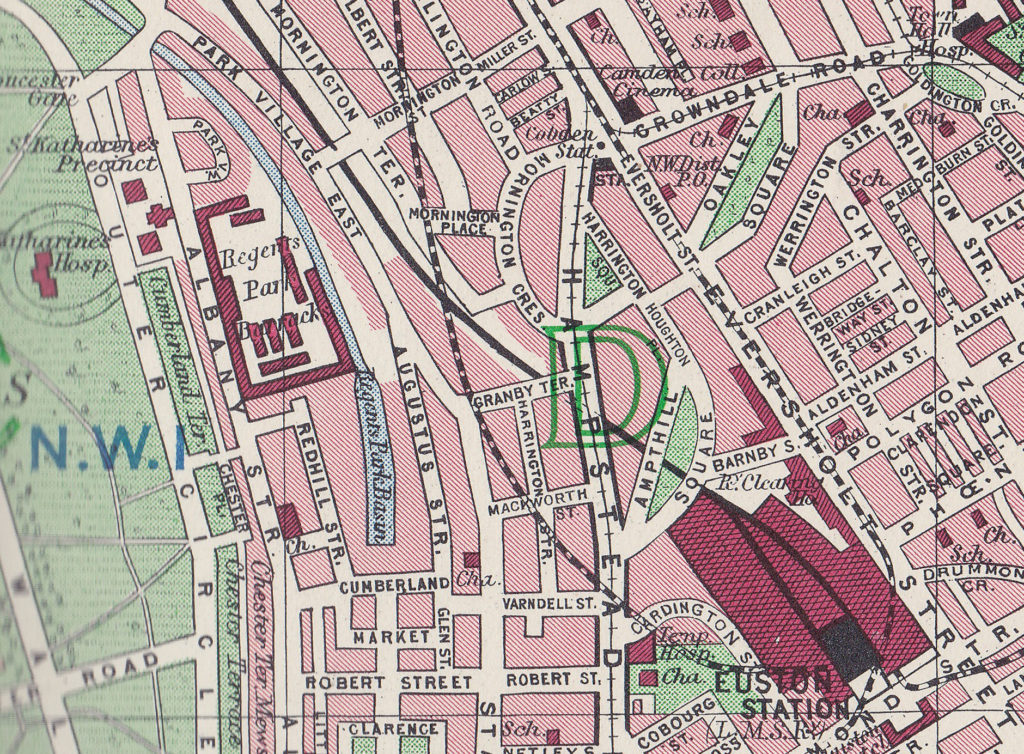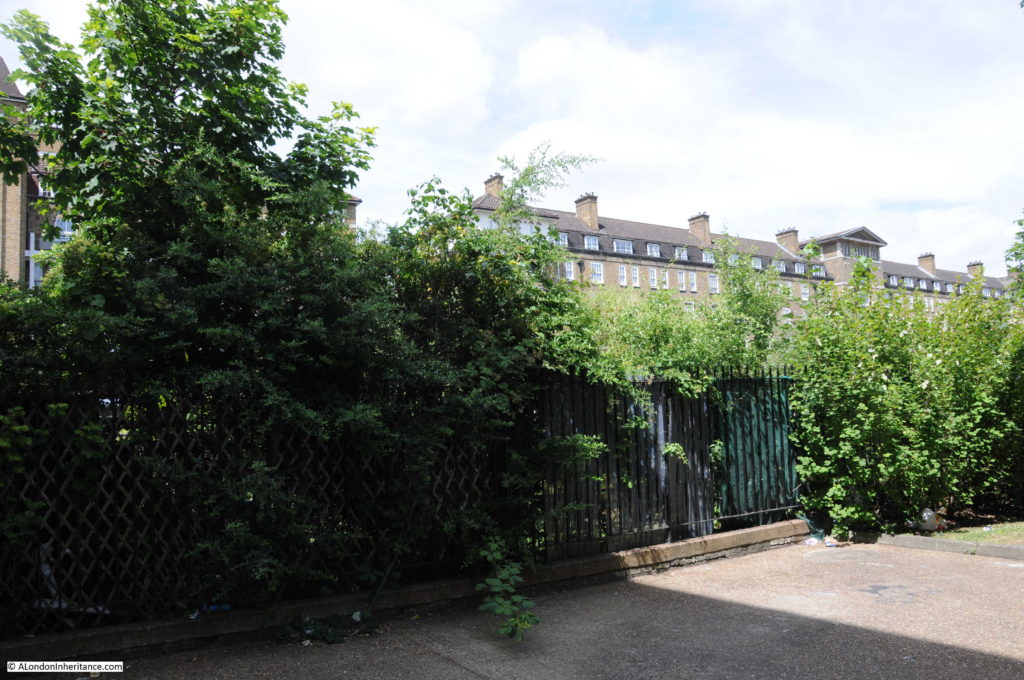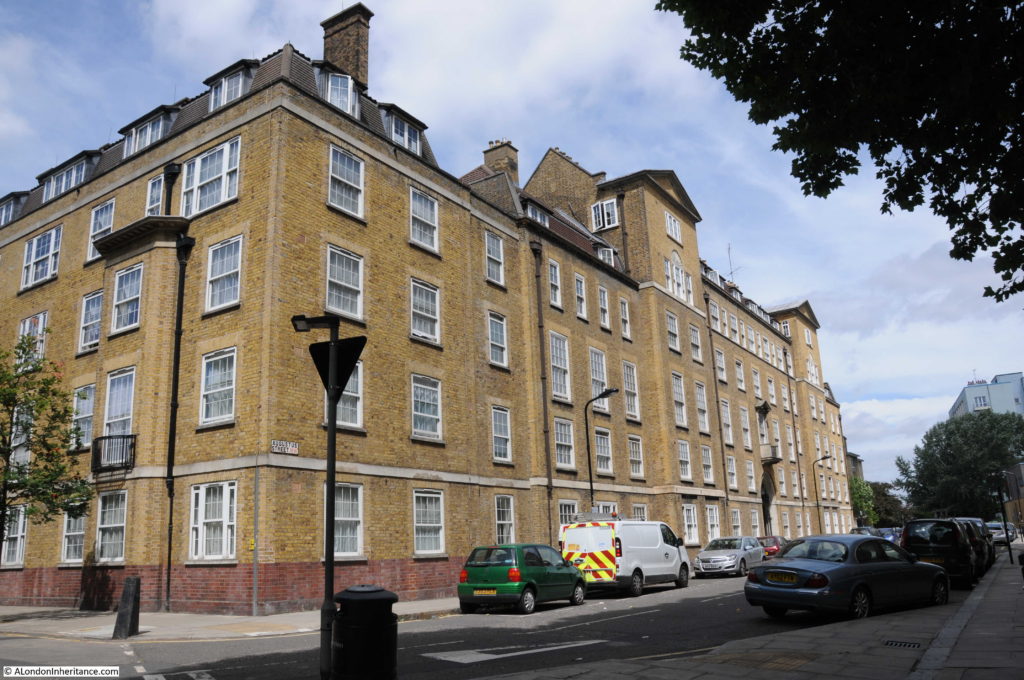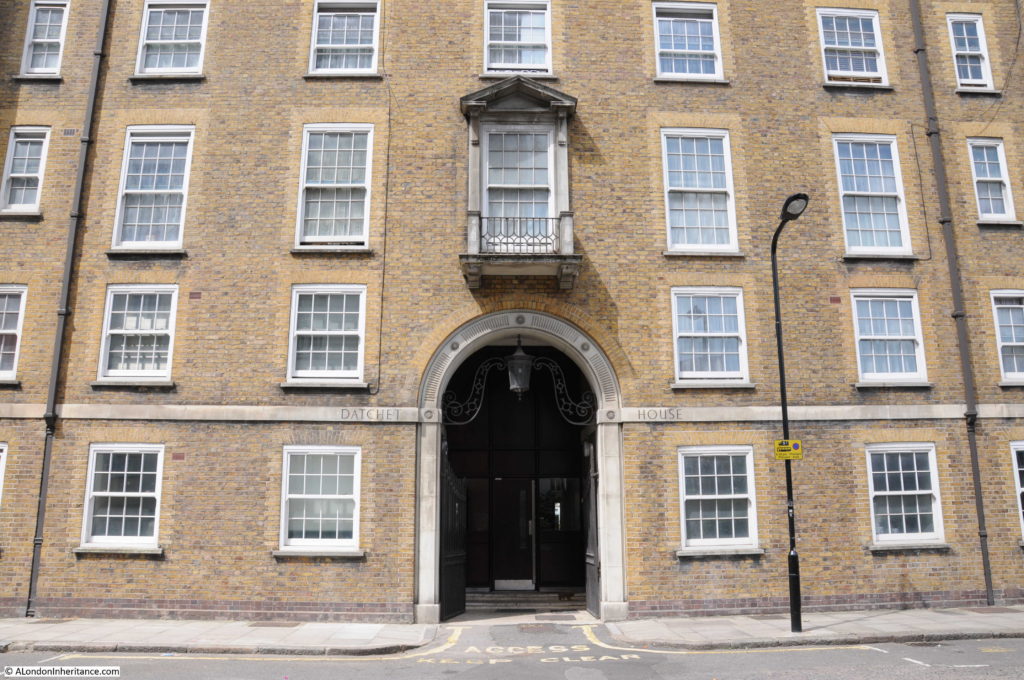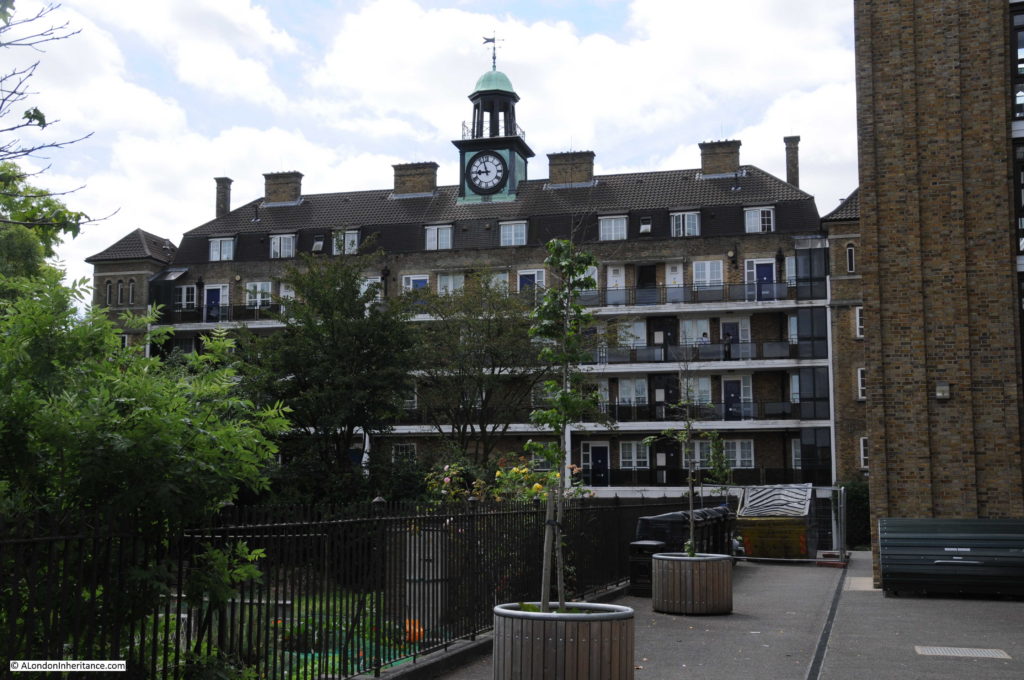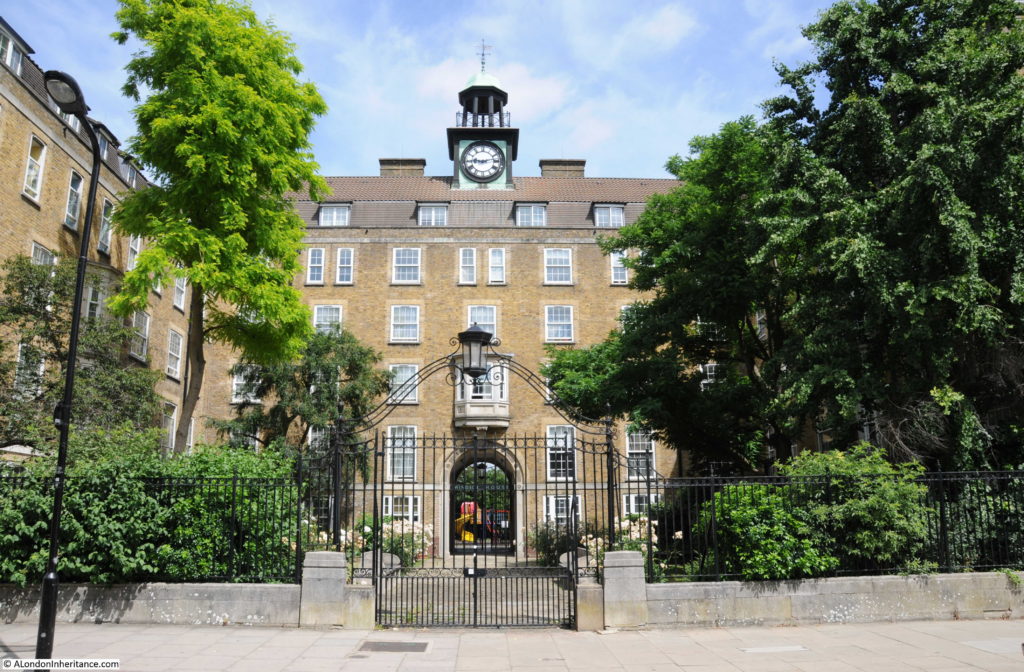For this week’s post, I am in for me, a rather special place. This is the Peabody Cumberland Market Estate, a large estate of flats, mainly completed by 1937 and built around the old Regents Park Basin, also known as the Cumberland Market Basin, built to facilitate delivery of hay, vegetables, ice and loads of other goods to Cumberland Market, which was located at the end of the basin.
It is a special place for me as my father moved into Bagshot House as a child in 1939, lived here throughout the war (apart from about 2 weeks of evacuation), and continued living here until the early 1950s.
Construction of the flats was started in the mid 1920s on land owned by the Crown Estate. The flats were built on land once occupied by warehouses, workshops and houses, all surrounding the Regents Park Basin. The basin was connected to the Regents Canal by a short run of canal that passed through Regents Park, then alongside the Regents Park Barracks. Cumberland Market was at the end of the basin. This extension of the canal was built in 1830.
The architect of the estate was C. E. Varndell and there is a street named after him running from Cumberland Market to the Hampstead Road.
The following map from the 1940 Bartholomew Atlas for Greater London shows the basin to the left of centre. In the above Peabody map you can see Redhill Street and Augustus Street with allotments now running through the centre of the estate on the area once occupied by the basin.
It was from these flats that for a child the rest of London was a playground, where the impact of war would be seen both in the distance and in his own block of flats and where a 14 year old would see the horrendous human consequences of the bombing of a civilian population.
It was also from the flats that immediately after the war he would set out walking and cycling to photograph London and a few of these photos include views of the estate.
If you return to the Peabody estate map at the top of the post, you will see Redhill Street, then Bagshot House, then Swinley House.
Swinley House was a long row of flats that faced onto the Regents Park Basin. When built, the basin was still full of water, however this was the post war view across what was the Regents Park Basin looking towards Swinley House.
I could not get to the exact same location, however this is roughly the same view today – I will explain why the views are so different after the photo below.
Firstly, if you look along the top of Swinley House, the roof level flats are missing along the left of the building in the post war photo. This was as a result of incendiary bombing in 1940 which I will describe later in this post.
Also in the post war photo all the land in front of Swinley House is full of rubble. This had once been the Regents Park Basin, however, during the war the basin and canal extension was gradually filled with the considerable volumes of rubble caused by bombing across the city.
As Cumberland Market had closed, the basin served no purpose, and therefore provided a convenient dumping ground.
The following extract is from my father’s account of his experiences in London during the war, written in the summer of 1945, and mentions the in filling of the basin. This was the year 1943.
London’s bomb sites continued to be cleared and building repairs carried out. The number of static water tanks increased as sites and basements became available, and huge piles of brick and masonry rubble appeared where buildings had once stood.
That section of the Regents Canal from its Camden Town branch to the Regents Park Basin had been filed in over a period of many weeks. The water had not been drained but remained beneath the layer of rubble which had been dropped from a continuous fleet of lorries reversing towards the basin and tipping the contents into the water until one very small area of water remained, massed with gasping fish. Luckily all the ducks had flown.
I often wondered what personal belongings and perhaps human remains were buried with the filling, and thought the loss of water foolhardy as air raids might well resume.
Cumberland Market became a Council Depot for building materials, huge mounds of sand and bags of cement, the site enclosed with old doors which were plentiful.
The large area in front of Swinley House is now occupied by allotments, as topsoil was placed over the rubble.
The following view is looking down the full length of the old Regents Park Basin towards where Cumberland Market would have been just after the flats at the very end. Swinley House is on the right.
The two buildings in the distance in the above photo are Euston Tower on the left and the BT Tower on the right which should help with the location and orientation of this area.
Walking back into the courtyard area, this is part of Bagshot House. My father lived in a flat along the first floor balcony on the left.
I stood in the courtyard imagining the scenes here in 1940. This extract from my father’s account is about the heavy bombing during the later half of 1940:
“On another night during this period our block of flats and Swinley House directly opposite were showered with incendiaries. As father was on day shift at the time we were all in our beds resting as well as we were able, until the characteristic incendiary noise had us quickly out of bed. Father, a big man over six feet tall, the son of a fire chief officer and born in a fire station, was no man to hang about if a fire was in the offing. Donning his steel helmet, dressing gown over his pyjamas and a pair of slippers on his feet he rushed out of the doors and disappeared along the balcony towards the stairs. Mother called out to him in anguish but to no avail, the days of the horse drawn appliance rushing to a fire was in his blood. Up to the top floor directly above us he went, grabbing a stirrup pump in one hand and a bucket of water in the other. A pump with buckets of water and sand were normally available at each stair landing. An incendiary had crashed through the roof above, entering the top most flat, and in short time would no doubt have burnt its way through to us or at least have ruined all our possessions with water. However with the help of the occupier who was panicking for the A.F.S. (Auxiliary Fire Service) father soon had both the fire and the bomb extinguished.
Meanwhile, the incendiaries which had fallen on Swinley House went unnoticed. In one top floor flat bedroom windows could be seen the now familiar dazzling white light, soon turning to orange, as I watched from the bedroom window. Presently the roof began to burn through. Noticing figures in the courtyard below, now beginning to be illuminated by the flames, father could be seen rushing across to the stairs to grapple with this new challenge. The top floor balcony soon became doted with silhouettes of men throwing what they could salvage down to the courtyard, a dangerous and pointless task carried out in desperation, as anything of value would be looted before daylight. This fire was too advanced for stirrup pumps and buckets of water and due to the great number of fires that night a trailer pump did not arrive until the fire was well underway. In the meantime, my father and others carried on as best they could, eventually arriving home with blackened face, wet and filthy, his dressing gown and pyjama trousers singed, and slippers ruined. Concrete floors and stairways saved the block from complete destruction, the rooms and furniture directly beneath the top floor remaining soaked with sooty water for weeks. As for salvage, bedding was hung over balcony walls to dry, an unsatisfactory and lengthy process without an alternative. Furniture carried down to the courtyard and left to the elements until it could be carted away, that is what remained after further looting.”
The comments on looting are interesting, even within a reasonably enclosed estate. There are many examples of the “Blitz spirit” in my father’s accounts, but they also demonstrate that there will always be people willing to take advantage of the misfortune of others.
There are many accounts of happenings throughout the war on the estate in his written records, another extract from early 1944 during the “little blitz” again covers bombing directly on the estate:
” I wasn’t going to miss this chance of rushing out and extinguishing as many incendiaries as could be found, and after a short argument with mother over the chances of not coming back I shot out of the front door followed by father, although at this stage of the war he had become weary and lost some of his enthusiasm for fighting fires.
From all sides came the familiar sights and sounds. A mile or so over King’s Cross way was the great orange glow of many fires taking hold where the first missiles had fallen, and below in our courtyard and all around lay the incendiary bombs, burning with that intense incandescent, white light. Already many people were running from bomb to bomb with sandbags, dousing the bombs as best they could. Then came pandemonium. Explosions, cries and shouts from all sides. it seemed as though all hell had been let loose as there came hundreds of explosions from all around in quick succession.
Instinctively father and I dropped to the balcony floor behind the brick parapet wall that separated the balcony from the 20 foot drop to the courtyard below. For a minute or so we were completely dazed. The explosions had come suddenly and without warning and now, hot, steel fragments were whining in all directions.
As the explosions became less frequent I shakily joined father to peer over the wall to the courtyard below. Realisation came that these were not the old incendiaries which could be picked up or kicked into the gutter to burn out, these weapons were fitted with some anti-personnel device of explosive fitted to the original type of bomb, so timed to explode about three minutes after the bomb had ignited. In other words, just as some likely person, it could have been me or father, was stooping over to extinguish the bomb, which is exactly what had happened.
By the time the two of us had reached the courtyard, most of the bombs had thankfully blown themselves to pieces, saving the effort of having to extinguish them, but with the penalty of perhaps having a body riddled with white hot steel and burning magnesium.
The device had proved very successful as we watched lifeless and injured residents being carried away.”
Thankfully the courtyard is very peaceful today.
The following photo was taken on the balcony outside my father’s flat. looking out through the gap between Swinley House and Ascot House. The old Regents Park Basin is behind the railing, land where bombed buildings have been cleared is behind that, with houses along Stanhope Street in the distance.
I did consider walking up and along the balcony to take a photo of the above scene today, but this would be immediately outside people’s homes so decided not to, although I would love to have walked along the balcony and look down on the courtyard below.
The next photo is off Datchet House, along Augustus Street (see the estate map at the top of the post). I could not get a photo from the same position today as land in front of Datchet House which was a derelict bomb site when my father took the post war photo, has since been built on.
This is the view of Datchet House from the corner of Augustus Street and Cumberland Market. The entrance arch and ornate window help identify the position. Compare also the roof on the part of the building above the entrance arch in the photos above and below. You can see in the above photo the result of incendiary damage. the top floors of the building have since been rebuilt as shown in the photo below.
As with the rest of the estate Datchet House is in fine condition and the archway and ornate window seen in the above photo are still looking good.
The following photo is of the end of Datchet House (on the right of the photo) with Windsor House running along Cumberland Market, the large block that runs to the left of the photo.
Again, due to building on the derelict land in front of the flats there was no view of the flats from the position of the above photo today, so the photo below is of Windsor House from the corner of Augustus Street and Cumberland Market.
The original photo was taken on the corner of Stanhope Street and Varndell Street. This is the view today looking in the same direction – new building completely obscuring the view, however if you look to the bottom left or both the photo below and the post war photo you will see the same rectangular manhole cover on the corner of the pavement.
Returning to Swinley House, this is the view along the front facade of Swinley House that once faced the basin and now the allotments. The railings are along the original edge of the basin.
This is the view from the opposite end to the above photo, the whole allotment area on the left was once the Regents Park Basin.
At the far end of what was the Regents Park Basin, and now the allotments, in between the basin and the old Cumberland Market is a rather ornate block of flats with a clock tower:
This is the view from the opposite side, this is all Windsor House, but this section is indented with gardens and an ornate gateway facing onto Cumberland Market.
Bagshot House is one of the very few homes or workplaces that remain in London where my family have lived in or worked over the years. Most of these places have long since been demolished.
The Crown Estate attempted to sell the estate in 2011, however a campaign to resist the sale to developers resulted in Peabody taking over the estate and it looks incredibly well run. It is good to see the flats looking externally much as they would have when my father lived there during the war.


